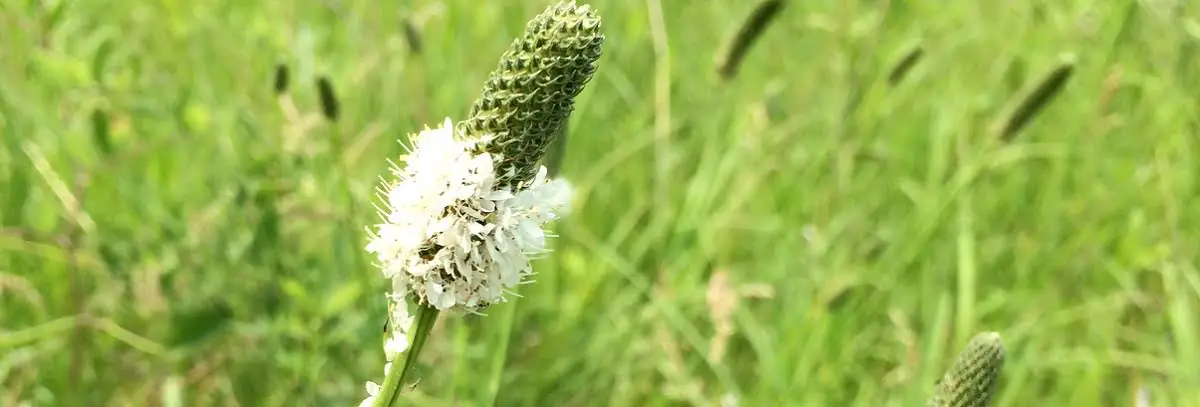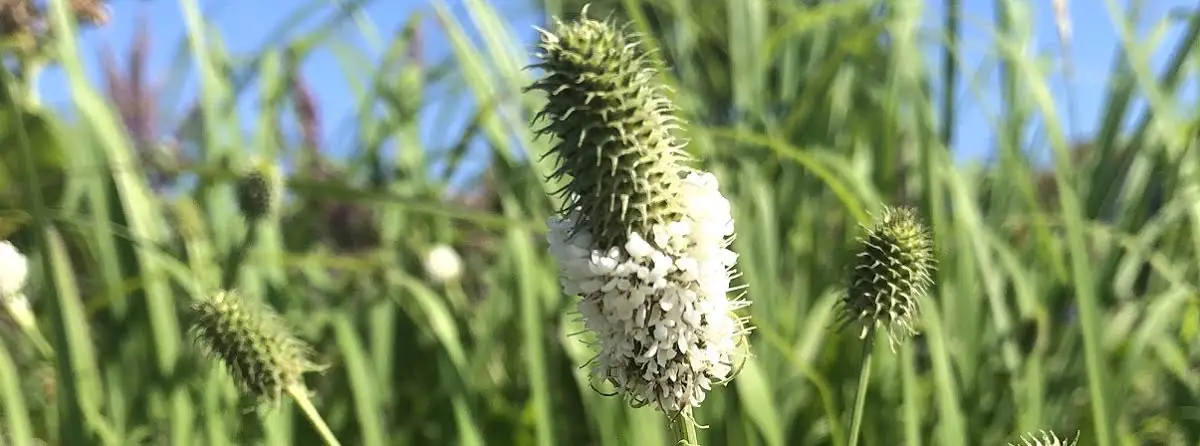Planting White Prairie Clover Guide What You Need To Know
White Prairie Clover A Green Manure Cover Crop

You can use white prairie clover (Dalea candida) as a cover crop. Being a legume family member, it adds nitrogen to the soil, helps prevent weeds from moving in, and is a source of green manure.
It attracts beneficial insects and pollinators like bees and butterflies to our garden.
It has a high tolerance for droughts and can survive in dry soils since its taproot can reach a depth of 5 feet.
You can find it naturally growing on well-drained sandy, gravelly, silt soils and sometimes on clay and lowland sites.
It can germinate across a wide range of temperatures making it useful in areas where soil temperature fluctuations get encountered.
It grows best in full sun but can also do well in partial shade and does not tolerate consistently wet soils.
It looks great in our gardens, especially when we mix in her sister Purple Prairie Clover. If you have rabbits in your area, you might want to go with a different plant since they love to eat these seedlings.
Is White Prairie Clover an Annual or Perennial
White prairie clover is a warm-season perennial herbaceous legume native to North America.
Seed production should get expected in the plant's second growing season.
What Does White Prairie Clover Look Like
Stem: One to multiple stems will grow from its taproot or superficial or subterranean caudex. The stems are herbaceous(non-woody), with a few rigid branches forming at the top of the plant.
Leaves: Their leaves go in an alternate arrangement along the stem with an odd-pinnately compound and are 2 to 6 cm long.
Every compound leaf typically has 7 leaflets but can have 5 up to 9 at a length of 1 to 3 cm and width of 2 to 6 mm.
The leaflets have a narrow Lance-shaped with a sharp tip. You will find glandular dotted folded along the central vein on the lower surface.
Flower: It creates white flower petals uncommon for the legume family, with one standard and four narrow petal-like bodies. These bodies are joined by the five stamen bases forming the flowers calyx tube.

The arrangement of flowers is a terminal spike with a cylindrical shape (1 to 5 cm) and lax densely flowered. The tiny flowers are individual and clustered all around the terminal tip.
Fruit: The legume is covered with hairs and is between 2.5 to 4.5 mm long, containing one smooth brown seed that is kidney-shaped and 1.5 to 2 mm long.
White Prairie Clover Bloom
The plant will begin to create its white flowers in early to mid-June all the way into August.
The flowers will bloom beginning from the bottom of the spike, moving up the spike as blooming continues through the season.
Where Does White Prairie Clover Grow
In the US, they are rated as hardy to Zones 3, 4, 5, 6, 7, 8, and 9.
White Prairie Clover Growth Stages
- 1) Germination
- 2) Seminal Taprooted Stage
- 3) Fragmentation of the Taprooted Plant
- 4) Clonal Growth Stage
- 5) Flowering
- 6) Fruiting (Pod creation)
White Prairie Clover Soil type
This clover likes to grow in loam, sand, part gravel, silt soils, and in rare occurrences on clay and lowland sites. The ground needs to be well draining, not having polling water on them for long.
The biggest issue with clay soils is their tendency to get waterlogged, and if that happens, our clover will not be able to survive.
For the best growth, we need our soil to have a pH between 6.2 - 7.5.
Growing White Prairie Clover
White prairie clovers do not perform well in heavy clay soils since they tend to hold onto too much water and have lousy drainage.
If that is the type of soil you have, you will have to add more organic matter or use raised beds with well-draining soil.
Field beans perform best in a pH between 6.2 to 7.5.
Now use a spade to help break up the ground to provide better aeration. Then use your garden rake and level your garden plot.
You will plant the seeds between .25 to .5 inches deep. We want them deep enough to access moisture while allowing them to sprout as quickly as possible.
Water well, and ensure your garden plot is nice and moist.
Germination
Multiple factors will alter how long it takes for our clover to germinate. The seeds planted depth, available moisture, and temperature all change the germination speed we will see.
Under ideal conditions, we will see them sprout within 6 to 9 days, but it can range between 3 and 30 days.
White prairie clover has a high germination rate in temperatures between 60F and 85F (15 to 30 degrees C).
We will plant the seeds .25 to .5 inches (6 to 12 mm) deep.
It has a low germination rate when used in broadcast seeding, so we need to directly plant the seeds or increase the number of seeds we use.
The seeds need seed-to-soil contact to ensure they have the highest chance of successfully germinating.
White Prairie Clover germination rates can increase if we penetrate their hard outer shell (Seed Scarification). I like to gently rub them with sandpaper or let them soak overnight in warm water.
White Prairie Clover Seeding Rate
In my home garden, I would plant 4 seeds for every square foot where I would like them.
On a large scale, if you use a total seeding rate, it is suggested to use 4 pounds per acre. This is not very common since white prairie clover is generally used as a minor component in native seed mixtures using .5 pounds per acre.
White Prairie Clover Fertilizer Requirments
You do not need to add any fertilizer; adding nitrogen tends to cause damage to the plant.
If you are adding a fertilizer, stick to one that does not contain nitrogen. Something like an NPK of 0-10-10 or 0-20-20 will work well.
White Prairie Clover Root System
The plant has a deep-rooted taproot that can reach a depth of up to 5 feet.
How Tall Are White Prairie Clover?
The plant will grow between 1 to 3 feet (30 to 90 cm) tall.
White Prairie Clover Sunlight Requirments.
For best growth, we want to find a location with full sun for them. They will perform in partial shade, but their blooming will be reduced, and it is unlikely for the plant to survive when in full shade.
Companion Plants:
- 1) Purple Prairie Clover (Dalea purpureum)
- 2) Leadplant
- 3) Big Bluestem
- 4) Butterflyweed
- 5) Wild Bergamot
- 6) Compass Plant
Killing White Prairie Clover
Wildlife can kill our white prairie clover, and we can replicate this by chopping down or mowing the plant a few times, and they will stop regrowing.
White Prairie Clover Cover Crop Benefits
- Protects our garden soil from erosion
- Tilling it into your soil as green manure helps improve our soil's fertility.
- Their long tap root makes them highly drought tolerant
- Good ability to take nitrogen from the air and move it into our soil.
- Like other cover crops, it mixes well with other plants.
- Grows well in most soil types as long as they do not get waterlogged.
- It will not spread aggressively like many other cover crops.
Summary
Adding white prairie clover can help protect our soil from erosion and improve its microorganisms.
Their ability to take nitrogen from the air and move it to our soils as an organic fertilizer. This is a great way we can increase our soil's nutrients organically.
We can further improve the soil by tilling the prairie clover into our ground to add more organic material.
Similar Articles
Crimson Clover Cover Crop Green Manure Guide
Planting White Clover
Planting Alsike Clover
Planting Field Beans
[1]https://www.gardenia.net/plant/dalea-candida
[2]https://grownative.org/native_plants/white-prairie-clover/
[3]https://kb.jniplants.com/white-prairie-clover-dalea-candida/
[4]https://northernwildflowers.ca/products/white-prairie-clover
[5]https://www.outsidepride.com/seed/clover-seed/white-prairie-clover-seed.html
[6]https://www.wildflower.org/plants/result.php?id_plant=DACA7
[7]https://www.friendsofthewildflowergarden.org/pages/plants/whiteprairieclover.html
[8]https://www.illinoiswildflowers.info/prairie/plantx/wpr_cloverx.htm
[9]https://kb.jniplants.com/white-prairie-clover-dalea-candida/